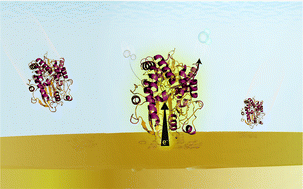Single enzyme electroanalysis
Abstract
Traditional studies of enzymatic activity rely on the combined kinetics of millions of enzyme molecules to produce a product, an experimental approach that may wash out heterogeneities that exist between individual enzymes. Evaluating these properties on an enzyme-by-enzyme basis represents an unambiguous means of elucidating heterogeneities; however, the quantification of enzymatic activity at the single-enzyme level is fundamentally limited by the maximum catalytic rate, kcat, inherent to a given enzyme. For electrochemical methods measuring current, single enzymes must turn over greater than 107 molecules per second to produce a measurable signal on the order of 10−12 A. Enzymes with this capability are extremely rare in nature, with typical kcat values for biologically relevant enzymes falling between 1 and 10 000 s−1. Thus, clever amplification strategies are necessary to electrochemically detect the vast majority of enzymes. This review details the progress toward the electroanalytical detection and evaluation of single enzyme kinetics largely focused on the nanoimpact method, a chronoamperometric detection strategy that monitors the change in the current-time profile associated with stochastic collisions of freely diffusing entities (e.g., enzymes) onto a microelectrode or nanoelectrode surface. We discuss the experimental setups and methods developed in the last decade toward the quantification of single molecule enzymatic rates. Special emphasis is given to the limitations of measurement science in the observation of single enzyme activity and feasible methods of signal amplification with reasonable bandwidth.

- This article is part of the themed collections: Analyst Recent HOT articles and Recent Review Articles


 Please wait while we load your content...
Please wait while we load your content...
